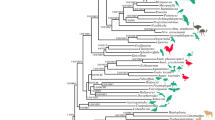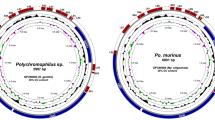Abstract
Mammals host a wide diversity of parasites. Lice, comprising more than 5,000 species, are one group of ectoparasites whose major lineages have a somewhat patchwork distribution across the major groups of mammals. Here we explored patterns in the diversification of mammalian lice by reconstructing a higher-level phylogeny of these lice, leveraging whole genome sequence reads to assemble single-copy orthologue genes across the genome. The evolutionary tree of lice indicated that three of the major lineages of placental mammal lice had a single common ancestor. Comparisons of this parasite phylogeny with that for their mammalian hosts indicated that the common ancestor of elephants, elephant shrews and hyraxes (that is, Afrotheria) was the ancestral host of this group of lice. Other groups of placental mammals obtained their lice via host-switching out of these Afrotherian ancestors. In addition, reconstructions of the ancestral host group (bird versus mammal) for all parasitic lice supported an avian ancestral host, indicating that the ancestor of Afrotheria acquired these parasites via host-switching from an ancient avian host. These results shed new light on the long-standing question of why the major groups of parasitic lice are not uniformly distributed across mammals and reveal the origins of mammalian lice.
This is a preview of subscription content, access via your institution
Access options
Access Nature and 54 other Nature Portfolio journals
Get Nature+, our best-value online-access subscription
$29.99 / 30 days
cancel any time
Subscribe to this journal
Receive 12 digital issues and online access to articles
$119.00 per year
only $9.92 per issue
Buy this article
- Purchase on Springer Link
- Instant access to full article PDF
Prices may be subject to local taxes which are calculated during checkout


Similar content being viewed by others
Data availability
All data needed to evaluate the conclusions in the paper are present in the paper and/or the Supplementary Information. Phylogenomic data generated in this study are available at figshare (https://doi.org/10.6084/m9.figshare.18737423).
References
Wilson, D. E., Mittermeier, R. A. & Cavallini, P. Handbook of the Mammals of the World Vol. 1 (Lynx Edicions, 2009).
Meredith, R. W. et al. Impacts of the Cretaceous terrestrial revolution and KPg extinction on mammal diversification. Science 334, 521–524 (2011).
dos Reis, M. et al. Phylogenomic datasets provide both precision and accuracy in estimating the timescale of placental mammal phylogeny. Proc. R. Soc. B 279, 3491–3500 (2012).
O’Leary, M. A. et al. The placental mammal ancestor and the post-K–Pg radiation of placentals. Science 339, 662–667 (2013).
Upham, N. S., Esselstyn, J. A. & Jetz, W. Inferring the mammal tree: species-level sets of phylogenies for questions in ecology, evolution, and conservation. PLoS Biol. 17, e3000494 (2019).
Murphy, W. J., Foley, N. M., Bredemeyer, K. R., Gatesy, J. & Springer, M. S. Phylogenomics and the genetic architecture of the placental mammal radiation. Annu. Rev. Anim. Biosci. 9, 29–53 (2021).
Álvarez-Carretero, S. et al. A species-level timeline of mammal evolution integrating phylogenomic data. Nature 602, 263–267 (2022).
Kim, K. C. Coevolution of Parasitic Arthropods and Mammals (Wiley, 1986).
Johnson, K. P. et al. Simultaneous radiation of bird and mammal lice following the K–Pg boundary. Biol. Lett. 14, 20180141 (2018).
Hafner, M. S. & Nadler, S. A. Phylogenetic trees support the coevolution of parasites and their hosts. Nature 332, 258–259 (1988).
Huelsenbeck, J. P. & Rannala, B. Phylogenetic methods come of age: testing hypotheses in an evolutionary context. Science 276, 227–232 (1997).
Page, R. D. M. & Charleston, M. A. Trees within trees: phylogeny and historical associations. Trends Ecol. Evol. 13, 356–359 (1998).
Nieberding, C. M. & Olivieri, I. Parasites: proxies for host genealogy and ecology? Trends Ecol. Evol. 22, 156–165 (2007).
Allen, J. M., Worman, C. O., Light, J. E. & Reed D. L. in Developments in Primatology: Progress and Prospects Vol. 38 (eds Brinkworth, J. & Pechenkina, K.) 161–186 (Springer, 2013).
Clayton, D. H., Bush, S. E. & Johnson, K. P. Coevolution of Life on Hosts: Integrating Ecology and History (Univ. Chicago Press, 2015).
Althoff, D. M., Segraves, K. A. & Johnson, M. T. J. Testing for coevolutionary diversification: linking pattern with process. Trends Ecol. Evol. 29, 82–89 (2014).
Hayward, A., Poulin, R. & Nakagawa, S. A broadscale analysis of host-symbiont cophylogeny reveals the drivers of phylogenetic congruence. Ecol. Lett. 24, 1681–1696 (2021).
Price, R. D., Hellenthal, R. A., Palma, R. L., Johnson, K. P. & Clayton, D. H. The Chewing Lice: World Checklist and Biological Overview (Illinois Natural History Survey, 2003).
Durden, L. A. & Musser, G. G. The Sucking Lice (Insecta, Anoplura) of the World: A Taxonomic Checklist with Records of Mammalian Hosts and Geographical Distributions (American Museum of Natural History, 1994).
de Moya, R. S. et al. Phylogenomics of parasitic and non-parasitic lice (Insecta: Psocodea): combining sequence data and exploring compositional bias solutions in next generation datasets. Syst. Biol. 70, 719–738 (2021).
Reed, D. L., Light, J. E., Allen, J. M. & Kirchman, J. J. Pair of lice lost or parasites regained: the evolutionary history of anthropoid primate lice. BMC Biol. 5, 7 (2007).
Light, J. E., Smith, V. S., Allen, J. M., Durden, L. A. & Reed, D. L. Evolutionary history of mammalian sucking lice (Phthiraptera: Anoplura). BMC Evol. Biol. 10, 292 (2010).
Balbuena, J. A., Míguez-Lozano, R. & Blasco-Costa, I. PACo: a novel Procrustes application to cophylogenetic analysis. PLoS ONE 8, e61048 (2013).
Santichaivekin, S. et al. eMPRess: a systematic cophylogeny reconciliation tool. Bioinformatics https://doi.org/10.1093/bioinformatics/btaa978 (2020).
Boyd, B. M. et al. Long-distance dispersal of pigeons and doves generated new ecological opportunities for host-switching and adaptive radiation by their parasites. Proc. R. Soc. B https://doi.org/10.1098/rspb.2022.0042 (2022).
Catanach, T. A. & Johnson, K. P. Independent origins of the feather lice (Insecta: Degeeriella) of raptors. Biol. J. Linn. Soc. 114, 837–847 (2015).
de Moya, R. S. et al. Extensive host-switching of avian feather lice following the Cretaceous–Paleogene mass extinction event. Commun. Biol. 2, 445 (2019).
Hafner, M. S. et al. Disparate rates of molecular evolution in cospeciating hosts and parasites. Science 265, 1087–1090 (1994).
Page, R. D. M. (ed.) Tangled Trees: Phylogeny, Cospeciation, and Coevolution (Univ. Chicago Press, 2003).
Allen, J. M., LaFrance, R., Folk, R. A., Johnson, K. P. & Guralnick, R. P. aTRAM 2.0: an improved, flexible locus assembler for NGS data. Evol. Bioinform. 14, 1176934318774546 (2018).
Johnson, K. P., Weckstein, J. D., Herrera, S. V. & Doña, J. The interplay between host biogeography and phylogeny in structuring diversification of the feather louse genus Penenirmus. Mol. Phylogenet. Evol. 165, 107297 (2021).
Slater, G. S. C. & Birney, E. Automated generation of heuristics for biological sequence comparison. BMC Bioinform. 6, 31 (2005).
Katoh, K. & Standley, D. M. MAFFT multiple sequence alignment software version 7: improvements in performance and usability. Mol. Biol. Evol. 30, 772–780 (2013).
Capella-Gutiérrez, S., Silla-Martínez, J. M. & Gabaldón, T. trimAl: a tool for automated alignment trimming in large-scale phylogenetic analyses. Bioinformatics 25, 1972–1973 (2009).
Minh, B. Q. et al. IQ-TREE 2: new models and efficient methods for phylogenetic inference in the genomic era. Mol. Biol. Evol. 37, 1530–1534 (2020).
Degnan, J. H. & Rosenberg, N. A. Gene tree discordance, phylogenetic inference and the multispecies coalescent. Trends Ecol. Evol. 24, 332–340 (2009).
Zhang, C., Rabiee, M., Sayyari, E. & Mirarab, S. ASTRAL-III: polynomial time species tree reconstruction from partially resolved gene trees. BMC Bioinform. 19, 153 (2018).
Ronquist, F., Lartillot, N. & Phillips, M. J. Closing the gap between rocks and clocks using total-evidence dating. Phil. Trans. R. Soc. B 371, 20150136 (2016).
Legendre, P., Desdevises, Y. & Bazin, E. A statistical test for host–parasite coevolution. Syst. Biol. 51, 217–234 (2002).
Smith, V. S. et al. Multiple lineages of lice pass through the K–Pg boundary. Biol. Lett. 7, 782–785 (2011).
Johnson, K. P. et al. Phylogenomics and the evolution of hemipteroid insects. Proc. Natl Acad. Sci. USA 115, 12775–12780 (2018).
Paradis, E. & Schliep, K. ape 5.0: an environment for modern phylogenetics and evolutionary analyses in R. Bioinformatics 35, 526–528 (2018).
Acknowledgements
We thank J. Allen, K. C. Bell, I. Beveridge, S. Bush, T. Chesser, D. Clayton, C. Floyd, R. Furness, T. D. Galloway, S. Goodman, P. James, R. E. Junge, A. Lawrence, S. Leonardi, J. Malenke, S. Matthee, K. McCracken, M. Meyer, L. Mugisha, T. Nyman, B. O’Shea, E. Osnas, R. Palma, J. Scherer, V. Smith, T. Spradling, O. Sychra, W. Veronesi, D. Verrier, J. Weckstein and R. Wilson for assistance in obtaining specimens for this study. Funding was provided by US NSF DEB-1239788, DEB-1925487 and DEB-1926919 grant awards to K.P.J, and European Commission grant H2020-MSCA-IF-2019 (INTROSYM:886532) to J.D. We thank R. de Moya, S. Virrueta Herrera and K. K. O. Walden for assistance with DNA extraction. We thank A. Hernandez and the Roy J. Carver Biotechnology Center at the University of Illinois for assistance with genome sequencing. We thank K. K. O. Walden for assistance with submission of data to NCBI. Images copyright Lynx Edicions originally illustrated by H. Burn, F. Jutglar, T. Llobet, F. Peacock, L. Sanz, L. Solé and I. Velikov. We thank L. J. Revell for assistance with Fig. 2. We thank CSIRC personnel (Universidad de Granada, Spain) for assistance and providing computational resources (Alhambra supercomputer).
Author information
Authors and Affiliations
Contributions
K.P.J. designed the study, obtained funding and wrote the manuscript draft. C.M. provided critical samples and edited the manuscript. J.D. designed the study, conducted the analyses, prepared figures and edited the manuscript.
Corresponding authors
Ethics declarations
Competing interests
The authors declare no competing interests.
Peer review
Peer review information
Nature Ecology & Evolution thanks the anonymous reviewers for their contribution to the peer review of this work. Peer reviewer reports are available.
Additional information
Publisher’s note Springer Nature remains neutral with regard to jurisdictional claims in published maps and institutional affiliations.
Extended data
Extended Data Fig. 1 Summary of cophylogenetic reconstruction of optimal MPRs from eMPRess comparison (cost scheme duplication: 1, sorting: 1, and host-switching: 2) of the louse (concatenated) tree with the mammal host tree.
Arrows indicate direction of host-switches. Numbers associated with events are the percentage of MPRs with that event.
Extended Data Fig. 2 Summary of cophylogenetic reconstruction of optimal MPRs from eMPRess comparison (cost scheme duplication: 1, sorting: 1, and host-switching: 2) of the louse (coalescent) tree with the mammal host tree.
Arrows indicate direction of host-switches. Numbers associated with events are the percentage of MPRs with that event.
Extended Data Fig. 3 Jack-knifed squared residuals (bars) and upper 95% confidence interval (error bars) associated with each mammal-louse association (link).
Dashed line indicates the overall median squared residual value (n = 33 biologically independent samples).
Supplementary information
Rights and permissions
About this article
Cite this article
Johnson, K.P., Matthee, C. & Doña, J. Phylogenomics reveals the origin of mammal lice out of Afrotheria. Nat Ecol Evol 6, 1205–1210 (2022). https://doi.org/10.1038/s41559-022-01803-1
Received:
Accepted:
Published:
Issue Date:
DOI: https://doi.org/10.1038/s41559-022-01803-1
This article is cited by
-
Lice (Phthiraptera) diversity in ruminants and domestic birds in northeastern Algeria
International Journal of Tropical Insect Science (2023)
-
‘Tree of lice’ pinpoints first mammal with a louse infestation
Nature (2022)



